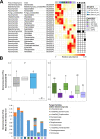Neighboring plants divergently modulate effects of loss-of-function in maize mycorrhizal phosphate uptake on host physiology and root fungal microbiota
- PMID: 32555651
- PMCID: PMC7299352
- DOI: 10.1371/journal.pone.0232633
Neighboring plants divergently modulate effects of loss-of-function in maize mycorrhizal phosphate uptake on host physiology and root fungal microbiota
Abstract
Maize, a main crop worldwide, establishes a mutualistic symbiosis with arbuscular mycorrhizal (AM) fungi providing nutrients to the roots from soil volumes which are normally not in reach of the non-colonized root. The mycorrhizal phosphate uptake pathway (MPU) spans from extraradical hyphae to root cortex cells housing fungal arbuscules and promotes the supply of phosphate to the mycorrhizal host in exchange for photosynthetic carbon. This symbiotic association with the mycobiont has been shown to affect plant host nutritional status and growth performance. However, whether and how the MPU affects the root microbial community associated with mycorrhizal hosts in association with neighboring plants, remains to be demonstrated. Here the maize germinal Mu transposon insertion mutant pht1;6, defective in mycorrhiza-specific Pi transporter PHT1;6 gene, and wild type B73 (wt) plants were grown in mono- and mixed culture and examined under greenhouse and field conditions. Disruption of the MPU in pht1;6 resulted in strongly diminished growth performance, in reduced P allocation to photosynthetic source leaves, and in imbalances in leaf elemental composition beyond P. At the microbial community level a loss of MPU activity had a minor effect on the root-associated fungal microbiome which was almost fully restricted to AM fungi of the Glomeromycotina. Moreover, while wt grew better in presence of pht1;6, pht1;6 accumulated little biomass irrespective of whether it was grown in mono- or mixed culture and despite of an enhanced fungal colonization of its roots in co-culture with wt. This suggested that a functional MPU is prerequisite to maintain maize growth and that neighboring plants competed for AM fungal Pi in low P soil. Thus future strategies towards improving yield in maize populations on soils with low inputs of P fertilizer could be realized by enhancing MPU at the individual plant level while leaving the root-associated fungal community largely unaffected.
Conflict of interest statement
The authors have declared that no competing interests exist.
Figures





References
-
- Giovannetti M, Sbrana C, Avio L, Strani P. Patterns of below-ground plant interconnections established by means of arbuscular mycorrhizal networks. New Phytol. 2004;164(1):175–81. - PubMed
Publication types
MeSH terms
Substances
LinkOut - more resources
Full Text Sources
Research Materials
Miscellaneous

